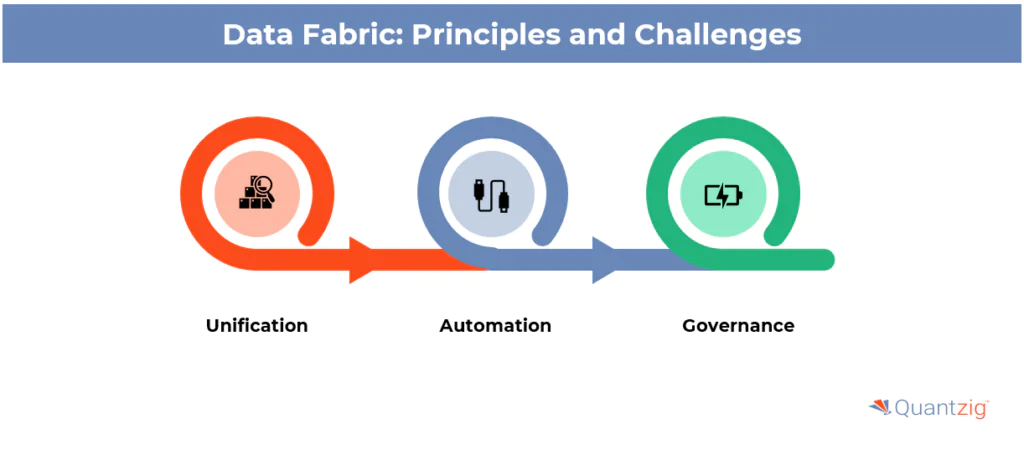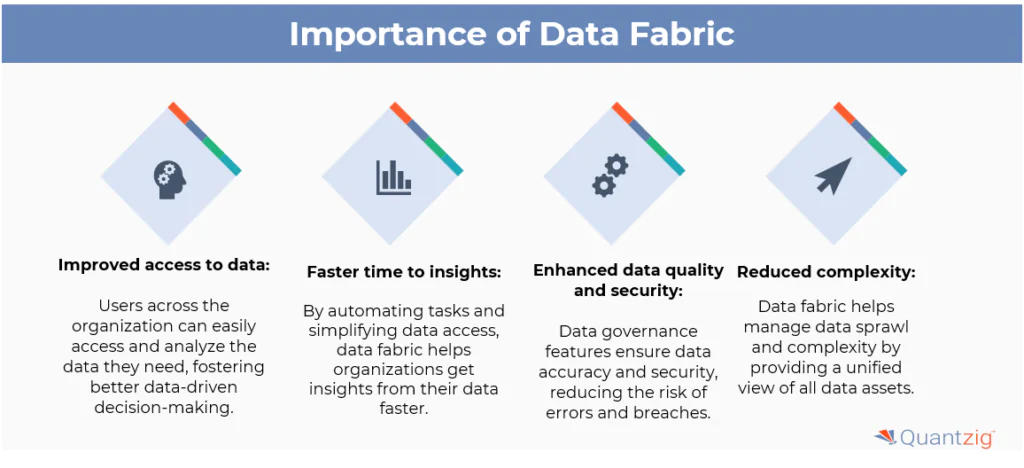Author: Associate Vice President, Analytics and Data Strategy, Quantzig.
Table of Contents
Data Fabric as a Revolution, Not an Evolution
Data fabric is rapidly emerging as a revolutionary concept in data management. Unlike previous incremental improvements, data fabric represents a fundamental shift in how organizations handle their ever-growing volumes of data. It aims to unify and simplify data management, breaking down traditional silos and enabling more efficient data usage across the enterprise.
Book a demo to experience the meaningful insights we derive from data through our analytical tools and platform capabilities. Schedule a demo today!
Request a Free DemoBrief Summary of Reporting and Analytics History
Historically, organizations have relied on various methods to manage and analyze data. Early systems included basic reporting tools and spreadsheets, which evolved into more sophisticated solutions like data warehouses and data lakes. These technologies have provided significant advancements in data storage and analysis but often resulted in fragmented data environments.

From Data Warehouses and Data Lakes to the Data Fabric Concept
Data warehouses centralized structured data for reporting and analysis, while data lakes allowed for the storage of vast amounts of unstructured data. Despite their benefits, these solutions often led to isolated data silos. The data fabric concept builds on these foundations but aims to provide a unified, integrated approach that connects all data sources, regardless of their format or location.
What is Data Fabric and How It Fits into Enterprise Data Environments
Data fabric is an architectural approach that creates a unified data layer, connecting disparate data sources across cloud and on-premise environments. This unified layer facilitates easier integration, access, and governance of data, allowing organizations to manage their data more effectively. By providing a single point of access, data fabric eliminates the need for complex data integrations and manual searches across different systems.
The Principles and Main Challenges of Data Fabric

Unification
Data fabric breaks down data silos by providing a single access point to all data, streamlining the integration process, and reducing the time and effort required to locate and use data from various sources.
Automation
A core principle of data fabric is automation. It leverages machine learning and other automation tools to handle data management tasks such as data movement, transformation, and integration, making these processes more efficient and less error-prone.
Governance
Data governance is integral to data fabric. It ensures data quality, security, and compliance with regulations, maintaining trust in the data and its usefulness for decision-making.
Data Fabric High-Level Design
The high-level design of a data fabric involves creating a unified architecture that spans various data sources and environments. This includes integrating cloud and on-premise systems, automating data management processes, and implementing robust data governance practices. The design aims to provide a seamless, scalable, and flexible solution that can adapt to the evolving needs of the organization.
Data Fabric as the New Data Management Platform: Why You Need It
Data fabric is becoming essential for modern data management due to its ability to provide improved access to data, faster time to insights, enhanced data quality and security, and reduced complexity. By addressing the limitations of traditional data management solutions, data fabric enables organizations to leverage their data more effectively for strategic decision-making.
How to Avoid Siloed Data with a Data Fabric?
A data fabric avoids siloed data by creating a unified layer that connects all data sources. This eliminates the need for separate data repositories and ensures that all data is accessible from a single point, facilitating easier integration and analysis.
Data Fabric Can Help with Eliminating SAP BW BEx and Building a Semantic Layer
Data fabric can streamline the transition from legacy systems like SAP BW BEx to modern data environments by integrating these systems into the unified data layer. It can also help build a semantic layer that provides a consistent and meaningful view of the data, making it easier to analyze and use for decision-making.
Experience the advantages firsthand by testing a customized complimentary pilot designed to address your specific requirements. Pilot studies are non-committal in nature.
Request a Free PilotBest Practices for Designing, Developing, and Deploying a Data Fabric
Core Tenets of Data Fabric
- Democratize Data: Ensure that data is accessible to all users across the organization, fostering data-driven decision-making.
- Ease Availability of Data: Simplify data access to enable users to quickly find and use the data they need.
- Exchange Data Efficiently: Facilitate seamless data exchange between different systems and platforms.
- Innovate Through Data Products: Use data to create new products and services that drive business innovation.
Why Is a Data Fabric Important?
Data fabric is important because it provides a scalable and flexible solution for managing data across an organization. It enables a holistic view of data, enhances analytics and insights, ensures data quality and governance, and supports future growth needs. By providing a self-service data access layer, data fabric empowers end users to leverage data more effectively.

Search and Coverage of Data
Data fabric ensures comprehensive search and coverage of data across the organization. It provides a unified view that enhances the ability to analyze and use data from various sources, driving better insights and decision-making.
Seamless Integration of Heterogeneous Data Sources Across Platforms Without Physical Data Movement
Data fabric enables seamless integration of diverse data sources without the need for physical data movement. This reduces complexity and improves efficiency by allowing data to remain in its original location while still being accessible and usable.
Scalable and Flexible Solution to Address Future Growth Needs
The scalable and flexible nature of data fabric makes it an ideal solution for organizations looking to address future growth needs. It can easily adapt to changes in data volume and complexity, ensuring that the data management infrastructure remains robust and effective.
Self-Service Data Access Layer for End Users
A key feature of data fabric is the self-service data access layer, which empowers end users to access and analyze data without relying on IT. This democratizes data and fosters a culture of data-driven decision-making across the organization.
Case Study: Modernizing Data Architecture for a Large Conglomerate
Client Overview
The client is a large conglomerate with diversified business operations spanning B2B, B2C, D2C, and B2G sectors. Their existing data architecture for Reporting and Analytics in Life Sciences (LS) was housed in an on-premises data warehouse. However, this setup had several limitations:
- The data warehouse automation tools were no longer supported.
- The current reporting solution needed modernization to improve data availability and visibility.
Client Problem
| Client Problem | Details |
|---|---|
| Data Warehouse Automation | The automation tools were out of support. |
| Reporting Solution | The existing solution needed modernization for better data availability and visibility. |
Quantzig Solution
| Quantzig Solution | Description |
|---|---|
| Data Architecture Migration | Migrated the client’s data architecture to Fabric. |
| Standardization | Implemented standardized and updated business logics and KPIs. |
| Modernization | Modernized the LS data warehouse and replaced unsupported tools. |
| Future Integration | Enabled future technology integration such as streaming data processing and AI workloads. |
Impact Delivered
| Impact Delivered | Results |
|---|---|
| Enhanced Data Availability | Improved data availability and visibility. |
| Standardization | Standardized data model, KPIs, and metrics. |
| Efficiency | Reduced manpower required for data quality, master data management (MDM), and data governance. |
Implementation Timeline
The entire migration to Fabric was completed within 7-8 months, ensuring a seamless transition and minimal disruption to the client’s ongoing operations.
Quantzig’s solution provided the client with a robust, modernized data architecture that supports advanced technology integrations and enhances operational efficiency. This transformation not only addressed the immediate issues but also positioned the client for future growth and innovation in data management.
Get started with your complimentary trial today and delve into our platform without any obligations. Explore our wide range of customized, consumption driven analytical solutions services built across the analytical maturity levels.
Start your free trialA Holistic View of Data – Enhanced Analytics and Insights
Data fabric provides a holistic view of all data assets, enhancing the ability to perform comprehensive analytics and gain deeper insights. This unified perspective supports more informed decision-making and drives business success.
Data Fabric Ensures That Data Quality, Lineage, and Governance Are Considered, Reducing the Risk of Using Unreliable Data
By incorporating robust data governance practices, data fabric ensures data quality, lineage, and security. This reduces the risk of using unreliable data and enhances trust in the data, making it more valuable for decision-making.
In conclusion, data fabric represents a significant advancement in data management, providing a unified, automated, and governed approach to handling the growing volumes of data in modern organizations. By addressing the limitations of traditional data management solutions, data fabric enables organizations to leverage their data more effectively and drive better business outcomes.
